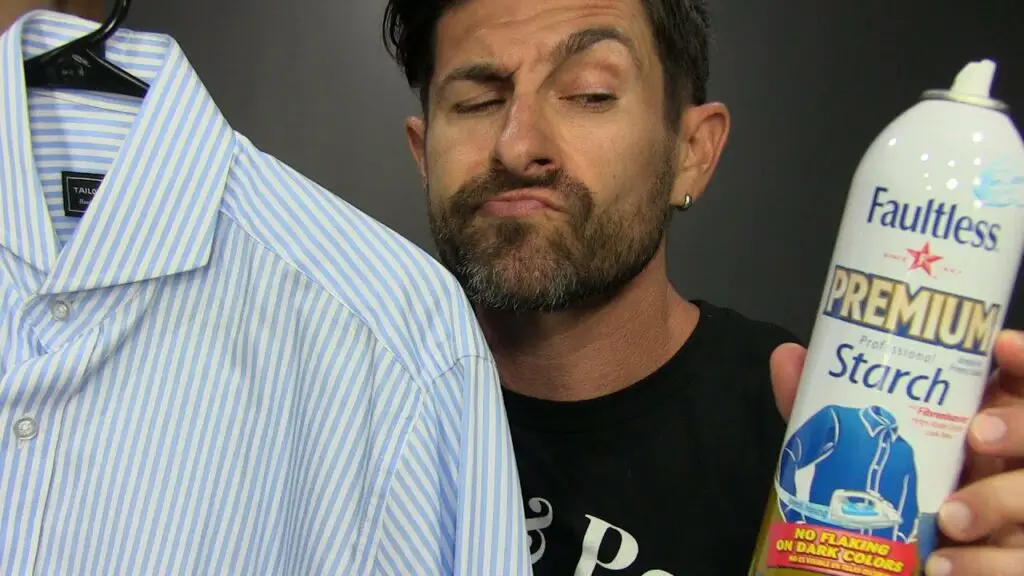Starching clothes isn’t a new practice. It got most popular during the 16th century. But, then it quickly went out of trend. The many benefits of starching clothes have finally brought it back in trend.
Starch can make your clothes very crisp. The clothes look neat, well-kempt, and are easy to iron too. Clothes remain crisp for a long time when starched in the right way.
Starch molecules attach themselves to the fabric of the clothes and it has many benefits such as preventing wrinkling and the ease of removing tough stains. Howbeit, you should not starch your clothes regularly.

Starching clothes is a very nice way to lend a professional look to your clothes. But, starching way too often can reduce the life of your clothes. It can break the fibers of cotton and linen.
Your clothes might not last for as long as they would have if you hadn’t used starch so often. This is the reason that many people do not starch their regular clothes.
Does it mean that using starch on your clothes is a mistake? Certainly not. Only excess of anything is harmful. Using starch in moderation on the right fabrics in the right way will make the clothes look so much better.
What is Starch: What are the Most Popular Types?
Organically a byproduct of photosynthesis, starch is used as a fabric stiffener. It has the quality of smoothing out the wrinkles by making the fabric crisp.
Starch binds itself to the fabric and makes a stiff, smooth, and invisible layer that works as a barrier between dust and stains from coming in direct contact with the fabric.
The following three kinds of starch are the most popular types amid launderers and laundresses.
1.) Wheat-based starch.
2.) Corn-based starch.
3.) Commercial starch.
Out of these three, it is the wheat-based starch that most laundry businesses prefer using. Wheat starch, out of the three, takes the lowest amount of heat to make the fabric stiffer. Less amount of heat naturally means that the fibers of the clothes will not be at the risk of burning.
Why Did Starch Go Out of Trend After the 16th Century?
Starch was popular amongst people in 16th century Europe. Fashion for women in Europe of the 16th century had signature narrow waist dresses that were wider at the hips.
Starch was a miracle discovery that gave the dresses the durability to hang on to the stiff appearance for a very long time.

Whether it was the pleated kilts for Scottish men or the ruffs that were popularised by Queen Elizabeth, Starch found its way from royals to the common public.
With all the hype around it, people started making innovations that led to the use of blue starch, red starch, and even green and yellow starch. It was a fashion disaster in London.
Soon, using starch became more of a mockery. Disapproval by prominent figures finally saw the downfall of Starch and it went out of trend towards the end of the 17th Century.
Starch has again emerged as a trend in the 21st century because, with better technology and careful usage, the benefits that it is offering are unparalleled.
Does Starch Make Clothes Last Longer: Is Starching Your Clothes a Mistake?
Usage of starch in the laundry business has given professionals an easy way to flaunt a neat appearance all the time. Ranging from dress pants to suit skirts, shirts, pants, jeans, denims, and pleated dresses, starch improves the appearance of all these garments.
However, overuse of starch or the usage of strong starch can weaken the fabric fibers, causing the fabric to turn brittle and tear.
We still stress the fact that it is the overused starch that causes all the problems listed above. The correct usage has benefits, not disadvantages. As long as you know how frequently to starch your clothes, the clothes will not tear unexpectedly.
See also: Why are Cowboys Jeans so Starched
5 Benefits of Applying Starch to Clothes
1.) Using Starch Keeps Corporate Clothes Crisp
Neatness to the point is very important in the corporate world. It’s not easy for the clothes to look smooth and stiff all day long if they are not starched.
When starched properly, the clothes hold their seam very strongly. Thus, you get to flaunt a top-notch look all day long.
2.) Using Starch Smoothes out Wrinkles
Sometimes, clothes develop very deep wrinkles that are not easy to remove. Even ironing can’t smoothen out the appearance of such wrinkles. So what do we do? We throw those clothes! Wherein, Starch can easily remove those wrinkles.
Applying starch to clothes makes it very easy to iron away all wrinkles from clothes. Since starch molecules bind themselves to the surface of the fabric, it holds the material very strongly. All the folds from the fabric can be made even, making the clothes look as neat as brand new.
3.) Using Starch Prevents Staining
Starch literally works as an added layer on the top of the fabric of the cloth it is applied to. Whatever dust or stain gets in contact with your clothes is binding itself to the topmost layer of starch, not the fabric directly. And, it is very easy to wash off starch.
It means that the stains that would have earlier left no option but to throw away your soiled clothes can now be stopped from coming in contact with the fabric of the clothes.
4.) Using Starch Makes Cleaning Clothes Easy
Washing away dirt from clothes has never been easier. Whether it’s the tricky collars and cuffs, or the sweat and stain marks from food, when they’re attached to the starch molecules, they can be washed away very easily by using a good quality detergent.
5.) Using Starch Protects the Color of the Fabric
Detergents attack stains. But, at times, they are so strong that they fade the color of the fabric. Excessive heat and sun exposure also fade the color of the fabric.
When you starch your clothes, the layer of starch takes the brunt of heat and detergents. As a result, the color of the fabric stays vibrant for a long time.
Cons of Using Starch Precariously and Way Too Often
1.) It Weakens the Fabric Fibers
Starch stiffens the fabric, and that’s both a boon and curse. It’s a boon because it keeps the clothes crisp for days.
But, if wheat starch is overused, it can make the clothes so stiff that the fabric fibers will actually break. Hence, it might tear your clothes from delicate places like the seam around the collars, pleats, and pockets.
2.) It Makes the Clothes Rough
If you’ve got sensitive skin, overusing starch might not be a good idea. When overused, it makes the clothes rough. Rough fabric from starch can cause problems such as rashes and itching when the skin is very sensitive.
Starching Clothes at Home: Is it Important to Take Your Clothes to Dry Cleaners for Starching every time?
Professional launderers and laundresses know what is the right strength and sufficient quantity of starch required for different kinds of fabrics.
Hence, people hand over their expensive work clothes at dry cleaners. But, giving all your clothes for dry cleaning can be very expensive. You can still give your most expensive garments to professionals, but you can save a lot of money by learning how to starch your clothes at home.
The best thing is that learning how to starch clothes at home isn’t rocket science either. Here’s what you have to do to apply starch to your clothes at home:
1.) Start by washing the clothes properly. Make sure they are properly dry before applying starch.
2.) Buy a very good quality iron board. You can also use a strong, entirely flat, and hard surface if you can’t afford an iron board.
3.) Spread the cloth you want to starch on an iron board very neatly and spray starch on the surface. Let the starch sit on the fabric for 4 to 5 minutes.
If you immediately iron the cloth, starch molecules might stick to the surface of the iron. So, let the starch dry for a few minutes before ironing.
4.) After a few minutes, start ironing the starched cloth. Make sure that the iron is already hot when you apply it to the cloth.
5.) Do not fold the cloth after ironing. Hand it properly in a hanger until it gets dry.
And you’re done! That’s about it.
Fabrics You Can and Cannot Starch
Now comes the million-dollar question, which fabrics can you starch and which ones should never be starched? Let’s walk you through the answers.
Fabrics you can starch – Cotton and linen (also known as flax fiber). For synthetic fabric, use sizing instead of starch.
Fabrics you should never starch – Wool, Silk, Nylon, and Chiffon. Even if the wool is blended with cotton, don’t starch it.
Do’s of Using Starch on Clothes
1.) Splay the cloth on a flat surface very nicely. Make sure there’s no fold.
2.) Evenly spray the starch on the fabric you’ve kept on top of the iron board.
3.) Let the starch sit on the surface for 5 minutes before ironing it.
4.) Hang the clothes and let them dry in the natural air.
5.) Do turn black clothes inside out before applying starch to them.
Don’ts of Using Starch on Clothes
1.) Don’t fold the clothes after you starch them.
2.) Don’t starch the clothes again and again. A single application of starch can last for many days.
3.) Don’t wash your clothes again and again after starching them. As we said, starch can keep the clothes wrinkle-free and smooth for days.
4.) Don’t use cheap-quality starch at all.
5.) Don’t use a lot of starch. Always read the instructions on the label to figure out how much starch is enough.
6.) Don’t apply starch to your regular clothes.
7.) Don’t apply starch to silk, silk blend, nylon, wool, and chiffon. Some fabrics are supposed to stay flowy.
8.) Don’t starch super expensive clothes at home.
9.) Though it is easy to starch at home and can save money, don’t starch at home at all if you are not confident enough.
10.) Don’t starch your UGs. It might cause a yeast infection if exposed to genitals.
Conclusion:
Applying starch to clothes keeps the surface crisp for a very long time – days and days. If you won’t overuse it, it is absolutely worth the hype.
Applying starch removes wrinkles, prevents wrinkles from occurring, protects the clothes from stains, and protects the color of the fabric too. When used in moderation, it certainly is a miracle product that everybody should use.







